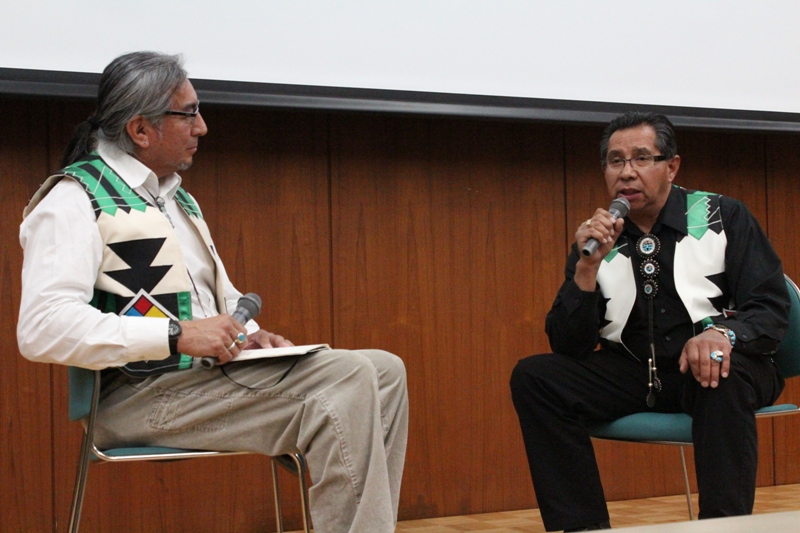 It is really fascinating to learn about one’s own country in a foreign country… Or at least that was my experience at yesterday’s アイヌ・アートが担う新たな役割―米国先住民アートショーに学ぶ Symposium (“Promotion and Communication of Ainu Arts and Culture: Learning from the Native American Art Shows in the U.S. Southwest”). In the true spirit of multicultural collaboration, the goal was to examine the role of the “art show” for the Zuni tribe (Pueblo Native Americans located around the four corners region of the United States), and consider how Ainu art and craft production could fit within such a framework.
It is really fascinating to learn about one’s own country in a foreign country… Or at least that was my experience at yesterday’s アイヌ・アートが担う新たな役割―米国先住民アートショーに学ぶ Symposium (“Promotion and Communication of Ainu Arts and Culture: Learning from the Native American Art Shows in the U.S. Southwest”). In the true spirit of multicultural collaboration, the goal was to examine the role of the “art show” for the Zuni tribe (Pueblo Native Americans located around the four corners region of the United States), and consider how Ainu art and craft production could fit within such a framework.
There were three presentations (Robert Breunig, Jim Enote, and Kaizawa Kazuaki), a dialogue with a Zuni artist (Octavius Seowtewa and Jim Enote), and a discussion panel (previous 4 speakers, Yamasaki Koji, and Ito Atsunori). The following are some issues/moments that stood out to me.
- What is an “art show“? Throughout the various presentations, the art show was described as having two primary motives. The first being the creation of a market for indigenous art production and the second being a way of communicating indigenous culture (and current conditions) to both the source community in addition to an outside market. Jim Enote described both the art show and the museum space as an ideal “contact zone” of cultures (a word that is also arising often in my own research). Issues concerning audience arose several times over the course of the afternoon, and many of the scholars questioned who an art show (or a museum) actually serves. However, it was mutually acknowledged with regard to the Zuni and the Ainu that both cultures had a long history of art exhibition (and production) that remained in need of attention.
- There was much discussion about the role and definition of the “traditional” and the “authentic” with regards to the artistic practice of indigenous peoples, and this was discussed in terms of form, material, and the problems associated with fervent copying of indigenous objects (both within one’s own country and internationally). A comment that was raised by Breunig and Enote was that the authenticity of materials (such as certain woods or stones) carries limited meaning if a context for the buying and selling of that art is absent. As such, Kaizawa and Enote both discussed the importance of an “Ainu brand” or a “Zuni brand” that facilitated educated buying of indigenous goods. In a memorable analogy, Enote compared buying indigenous art to buying wine. Wine-tasting seminars (and, conversely, the museum) help people to understand what they are buying by teaching them to discriminate between objects. If people learn to appreciate authenticity, then they will seek it out. Again, relating back to audience, the “they” here refers to the art connoisseur — what role do these objects play in the source community? How can a younger generation learn and innovate on the diverse artistic traditions?
- A member of the audience asked a tough question of the two Zuni members regarding the issue of a “national apology” for Japanese actions during the Meiji period in light of the new (national) Ainu museum scheduled to be built in Shiraoi by the Tokyo Olympics in 2020. Reflecting on the Zuni’s relationship with the United States government, Enote responded, “We don’t want an apology, we want a thank you.” Rather than apologizing for actions in the past that cannot be undone, a “thank you” involves a much more active acknowledgment of Zuni/Native American contribution to the history of the United States. There was an audible reaction from the audience on this one.
 The symposium’s spirit of collaboration was great, and there were many lessons to be learned on both sides. At the same time, such a format also makes apparent many unique issues for each group that do not have a strong parallels. For example, in the case of the Zuni, there is a real problem of other tribes copying Zuni goods for the market, thus undermining a “Zuni style” and devaluing Zuni labor.
The symposium’s spirit of collaboration was great, and there were many lessons to be learned on both sides. At the same time, such a format also makes apparent many unique issues for each group that do not have a strong parallels. For example, in the case of the Zuni, there is a real problem of other tribes copying Zuni goods for the market, thus undermining a “Zuni style” and devaluing Zuni labor.
It seems like many of the same speakers will continue the discussion along different lines at the National Museum of Ethnology in Osaka starting tomorrow (1/28) in an international workshop entitled, “Re-Collection and Sharing Traditional Knowledge, Memories, Information, and Images: Problem and the Prospects on Creating Collaborative Catalog.”
I really liked how you explored the role of the museum within the discussion of native art. Always interesting to see how the institution allows for a broader representation of both contemporary and historical artifacts that represent a culture’s material manufacturing.
Comments are closed.